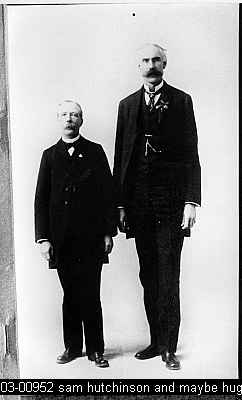
Sam Hutchinson looms over another man, possibly Hugh Dunlop in this photograph from an unidentified historical archive.
When my brothers were old enough to drive it wasn’t uncommon for several of us to pile into a car and head out into the Potholes to fish, swim or hike. We liked swimming in a certain hole in Hayes Creek. A favorite fishing spot was Hutchinson Lake, where red basalt cliffs rimmed the cool greenish waters. Even at that age, my father had told me plenty of stories about the Hutchinson brothers. My imagination placed old Sam Hutchinson on those clifftops, dressed in a black lawman’s cutaway coat and a flat-rimmed hat. Taller than seven feet, he once rode over those hills and lived in a cabin not far from where the lake is found.
Perhaps it was this image that inspired me to wander while my brother fished for those big trout that rarely got caught. I trudged out into the brush north of the lake looking for anything that might have been dropped by old Sam and he rode out one day. I found crushed and rusty tin cans, flaking apart. There were the remains of wire fencing smashed into the earth. Bits of purpled glass sparkled at me through the cheat grass. Then I found a rut. Continue reading →
Posted in Archaeology, Columbia Basin, Crab Creek, Education, Hiking, History, Native Americans, Soldiers, Trails, Transportation, Washington
Tagged Artifacts, Cariboo Trail, Central Washington, Central Washington University, Chelan, Chief Moses, Coconuts, Crab Creek, DeLorme, Desert, Eastern Washington, Education, Fishing, Fort Okanagan, Fort Vancouver, Hawaii, Hiking, History, Horses, Hudsons Bay Company, Hugh Dunlop, Hutchinson Lake, Indians, Native Americans, Nature, Potholes, Roads, Rock Creek, Sam Hutchinson, Sandwich Islands, Spokane, The Dalles, Trails, Washington, Wenatchee
 Lower Crab Creek provided water. In Eastern Washington, that was a godsend. Temperatures on the Columbia Plateau routinely soar to over 100 degrees Fahrenheit in the summertime, and rain is scarce. Cleaning irrigation ditches with a shovel west of Othello as a boy, many were the prayers I sent for even one scanty cloud to shield me from the overbearing sun.
Lower Crab Creek provided water. In Eastern Washington, that was a godsend. Temperatures on the Columbia Plateau routinely soar to over 100 degrees Fahrenheit in the summertime, and rain is scarce. Cleaning irrigation ditches with a shovel west of Othello as a boy, many were the prayers I sent for even one scanty cloud to shield me from the overbearing sun.
The Sinkiuse Indians who lived there before me probably shared my distaste for the relentless sun. But they didn’t have the benefit of a well of cold water I could retire to, an air conditioner that cooled the house when I took a break. They were stuck with the weather the way it was: hot in the summertime, cold in the winter. They took a more basic approach to living on the Columbia Plateau: they stuck close to water, or if that weren’t possible, they found the shortest route from one water hole to the next.
Over centuries of migration and travel, humans developed routes that guided them along the most direct lines of travel from one pool or stream of potable water to the next. Continue reading →
Posted in Anthropology, Archaeology, Books, Columbia Basin, Computer, Crab Creek, Family History, Hiking, History, Horses, Ice Age flood, Native Americans, Railroads, Saddle Mountain, Washington, World War II
Tagged Andrew Jackson Splawn, Anthropology, Archaeology, Astor Company, Ben Hutchinson, Beverly, Bridge, British Columbia, Bunchgrass, Burke Museum, Canada, Cariboo Trail, Celilo Falls, Central Washington, Cheat Grass, Chief Joseph, Chief Moses, Chinese, Columbia National Wildlife Refuge, Columbia Plateau, Columbia River, Colville Reservation, Corfu, Corfu Slide, Corfu Switchback, Cow Creek, Coyote Rapids, Crab Creek, Culture, Desert, Eastern Washington, Ellensburg, Environment, Family, Family History, Ferry, Frenchman Hill, Grand Coulee, Highway 26, History, Horses, Hutchinson's Hill, Ice Age, Ice Cave, Immigration, Indians, Kamiakin, Low Gap, Manashtash Ridge, Milwaukee Road, Missoula Flood, Model T, Moses Lake, Mount Adams, Nature, Nez Perce, Okanogan, Oregon, Othello, Perkins Murders, Plateau Indians, Quincy, Railroads, Ranchers, Rattlesnake Springs, Ross Cox, Rustlers, Saddle Gap, Saddle Mountain, Sagebrush, Sam Hutchinson, Seattle, Second World War, Sheriff, Similkameen, Sinkiuse, Taunton, Trails, Vantage, Wahluke, Wanapum, Warden, Washington, Washington State, Washington State Archives, Wenatchee, White Bluffs, World War II, Yakima, Yakima County, Yakima River


